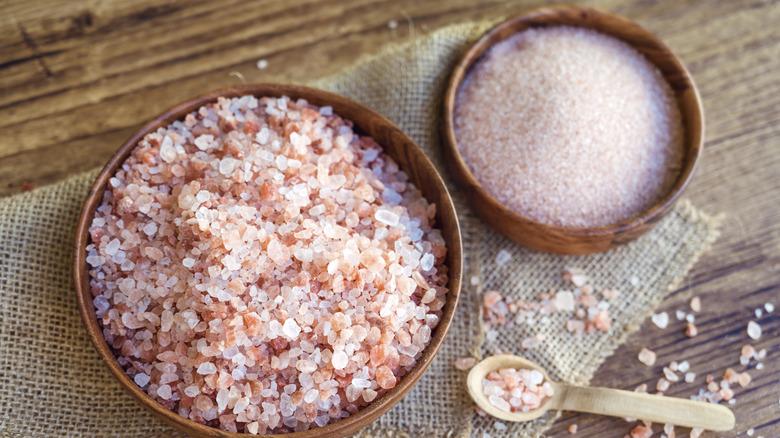This Type Of Salt Contains The Most Microplastics
It seems like no food is completely safe for consumption nowadays. Many popular species of fish have high levels of mercury, and canned mushrooms can contain maggots and mice. Now, it turns out that the salt you have on your table can have microplastics. It makes sense when you think about it: The sea has high levels of microplastics that get into sea salt, and these particles can also be airborne from things as common as synthetic fabrics used in clothes, skin care products with microbeads, and even car tires and roads, so they also get into terrestrial sources of salt. To help consumers, a 2022 study compared different types of salt to see which ones had the most amount of microplastics, concluding that coarse Himalayan pink salt was the worst offender.
Researchers used light microscopy technology to compare the salts and also included a control sample to make sure that the results were accurate. They found that coarse Himalayan pink salt had 174.07 microplastic particles per kilogram (2.2 pounds) of salt. Black salt had the second highest concentration, with 157.41 particles per kilogram. Maybe the worst news is that table salt, the most common type of this condiment, came in third place, with a worrisome 114.81 particles per kilogram.
Things to consider when buying salt
Measuring how microplastic affects us is difficult, and research is still inconclusive. However, some studies have linked our ingestion of these particles with negative intestinal issues, including Irritable Bowel Disease. It's also probably safe to infer that having plastic in our bodies isn't ideal. So, should you just give up salt completely? Probably not. After all, salt is the most important condiment you have in your kitchen, and cooking without salt is an unfathomable idea for most of us.
We can, however, take some steps towards reducing how many microplastics we're ingesting from salt. The World Health Organization recommends a maximum of 0.18 ounces of salt per day — a little under a teaspoon. Taking this into account, the 2022 study estimates that people are ingesting 155.47 particles of microplastics per year just from salt. To lower this amount, you can reduce your salt intake by adding less of it to your meals, or even cooking some dishes without it. You can also opt for the salts that have lower concentrations of microplastics. Interestingly, the study found that fine Himalayan pink salt came out at the bottom, with 27.78 particles per kilogram. The runner-ups are coarse sea salt, with 29.63 particles, and iodized salt, with 31.48.
Using these types of salts and lowering the amount you put in your food may help reduce your microplastic intake. Maybe it won't make a huge difference, but every bit of microplastic you avoid ingesting is likely a positive gain for your overall health.

